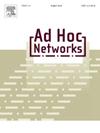未知三维地形下多isac -无人机移动搜索分布式拓扑控制
IF 4.4
3区 计算机科学
Q1 COMPUTER SCIENCE, INFORMATION SYSTEMS
引用次数: 0
摘要
在应急通信场景下,部署多架无人机可以快速提供通信覆盖和恢复网络连接。虽然现有的研究已经关注了多无人机网络中保持连通性的问题,但仍有一些问题没有得到充分的解决。本文研究了在搜索任务中部署具有集成传感和通信(ISAC)能力的多架无人机为地面移动用户提供数据收集和通信覆盖服务的场景。目标是在保证搜索过程中骨干网连通性的同时,最大限度地从所有用户收集数据的总和和最小化无人机网络的调整成本。通过对三维地形效果的建模,使仿真环境更加逼真。此外,本文假设搜索区域内的地形未知,因此移动用户的搜索轨迹也是未知的。因此,集中的方法是不可行的。为此,本文提出了一种分布式动态调整方案,即qos -连通性保证分布式调整(QCDA),以保证服务质量和网络连通性。通过仿真验证了该方案的有效性,其在数据采集、通信满意度、活动无人机数量以及无人机网络调整成本等方面的性能均优于基线。本文章由计算机程序翻译,如有差异,请以英文原文为准。
Distributed topology control of multiple ISAC-UAVs for mobile search teams in unknown 3-D terrains
In emergency communication scenarios, the deployment of multiple unmanned aerial vehicles (UAVs) can rapidly provide communication coverage and restore network connectivity. Though existing research has paid attention to the issue of maintaining connectivity in multi-UAV networks, there are still some problems that have not been fully addressed. This paper investigates the scenario of deploying multiple UAVs with integrated sensing and communications (ISAC) abilities to provide data collection and communication coverage services for ground mobile users in a search mission. The aim is to maximize the sum of data collected from all users and minimize the adjustment cost of the UAV network while ensuring Backbone network connectivity during the search. By modeling the effect of 3-D terrains, the simulation environment presented in this paper is more realistic. Moreover, this paper assumes that the terrain within the search area is unknown, thus the search trajectory of the mobile user is also unknown. As a consequence, centralized methods are infeasible. Accordingly, this paper proposes a distributed dynamic adjustment scheme, named QoS-Connectivity-Guaranteed Distributed Adjustment (QCDA), to ensure both quality of service and network connectivity. The efficiency of the proposed scheme is validated through simulations, and its performance in terms of data collection, communication satisfaction ratio, the number of active UAVs as well as the adjustment cost of the UAV network is better than the baselines.
求助全文
通过发布文献求助,成功后即可免费获取论文全文。
去求助
来源期刊

Ad Hoc Networks
工程技术-电信学
CiteScore
10.20
自引率
4.20%
发文量
131
审稿时长
4.8 months
期刊介绍:
The Ad Hoc Networks is an international and archival journal providing a publication vehicle for complete coverage of all topics of interest to those involved in ad hoc and sensor networking areas. The Ad Hoc Networks considers original, high quality and unpublished contributions addressing all aspects of ad hoc and sensor networks. Specific areas of interest include, but are not limited to:
Mobile and Wireless Ad Hoc Networks
Sensor Networks
Wireless Local and Personal Area Networks
Home Networks
Ad Hoc Networks of Autonomous Intelligent Systems
Novel Architectures for Ad Hoc and Sensor Networks
Self-organizing Network Architectures and Protocols
Transport Layer Protocols
Routing protocols (unicast, multicast, geocast, etc.)
Media Access Control Techniques
Error Control Schemes
Power-Aware, Low-Power and Energy-Efficient Designs
Synchronization and Scheduling Issues
Mobility Management
Mobility-Tolerant Communication Protocols
Location Tracking and Location-based Services
Resource and Information Management
Security and Fault-Tolerance Issues
Hardware and Software Platforms, Systems, and Testbeds
Experimental and Prototype Results
Quality-of-Service Issues
Cross-Layer Interactions
Scalability Issues
Performance Analysis and Simulation of Protocols.
 求助内容:
求助内容: 应助结果提醒方式:
应助结果提醒方式:


